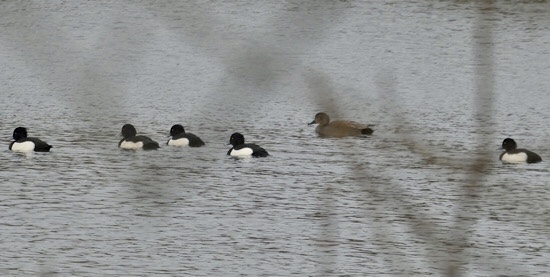Very heavy overnight rain stopped quite early. SW wind with occasional sunny spells.
Saltmarsh area - high water 08:50
Rock Pipit 2
Lapwing 80
Wigeon 180 along saltmarsh
This clip shows two things, first the activity on the saltmarsh edge, but also how much of the saltmarsh remains exposed on these 8.6m tides.
Even so, these early spring tides do tend to flush more snipe than you would expect:Common Snipe 39
Jack Snipe 1 - this was actually flushed by me as I walked around the outer saltmarsh edge. It landed again almost immediately in the middle of the saltmarsh.
Peregrine Falcon 1 (almost inevitable with the predictable snipe movement)
Middleton Nature Reserve
The overnight rain has raised the "no swimming" pond water level by 30cm! Even so the Gadwall seemed to be still reaching some weed, but they had deserted the main pond:
Mute 2 x 2 adult 3 + 6 cygnets
Moorhen 8
Coot 1 moved to main pond.
Mallard 5 on main pond
Gadwall 35 all on "no swimming" pond.
Tufted Duck 5 male
Shoveler 1 mature male
No sign of Teal, Wigeon or Pochard.
 |
| A distinct lack of female Tufted so far this winter! |
The diving ducks of course can still reach their food, the Gadwall appeared to be feeding around where the Tufted were diving. Presumably the Tufted were breaking some clumps of weed free to float to the surface (MD).
Pete and Jean managed to check some vantage points but the mid distance haze ruled out any distant searches.
Mediterranean gull 1 adult behind the dredger
Shag one feeding near the green marker post.
North shore
Brent geese
So far no reports from other observers. The following are just my observations (MD). There could have been more as the area was very busy and the birds were in at least two groups.
A walk out to the skear from Four Lane Ends at 13:35 saw only 2 Pale-bellied Brent fly in to the children's play area.
On returning at 15:00 there was a group of 13 on the outer rocks north of the play area, these included 2 Dark-bellied Brent. There was another group of 22 Pale-bellied Brent, including the Canadian ringed birds much closer to the play area. So at least:
Pale-bellied Brent 33
Dark-bellied Brent 2
Very similar to Pete C observation at the same time yesterday.
Heysham skear
Great Crested Grebe 2
Eider c100
Shelduck 4 out
Knot c150
Redshank c200 (Redshank numbers here always increase when we move to spring tides and more shore is exposed each tide)
Shag 1 juvenile feeding in shallow water. When feeding like this both Shag and Cormorant often snorkel to see what's around, before diving. This one does a bit of snorkelling early in this clip - note how its profile changes after wetting its head.
Well, here we are again....another year over.......another year older! This time last year, I said "at least we can now see some light at the end of what has seemed an endless tunnel" - I must have been using some remarkable optics! Although to be fair we did move into a brighter area for a while, so much so that I had resumed other activities and had planned to use this post to say that my ability to cover as much as I have been doing will inevitably reduce in 2022. But, for now I'm back to being, a self imposed, recluse! So, walking the area will remain my main activity for some while yet. Thanks for all the contributions that have helped me to compile the daily posts. The Observatory team of course, but several post readers have also sent me records and pictures. These are always welcome, and not necessarily of rare sightings, this post is partly about showing what can easily be seen in the Heysham area. So all information is of value, either via any member of the team or directly to me, my email address is on the side bar - Thanks. Malcolm.
Also last year I posed the question as to why the sea birds do not rest on the superstructure of No.2 outflow, and promised, some sort of answer by this year. We have all been watching more intently this year. There were two periods of extended calm weather when a few gulls rested on the upper rails, but not for long. The general consensus is that the outlet water surging around the hollow vertical supports causes vibrations that resonate around the structure, which must somehow be unpleasant to rest on. I am happy that is certainly part of it, but doesn't really explain why in two periods of calm weather the resonance was at least tolerable.
So all that remains is to wish everyone a
Happy New Year 2022!

1 comment:
Thanks to all who take the time to observe and make the daily posts. Very interesting. A happy new year to you.
Post a Comment